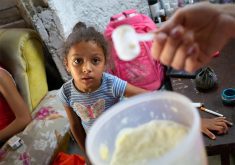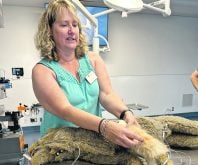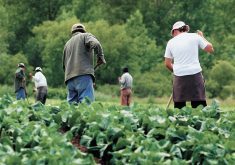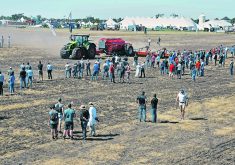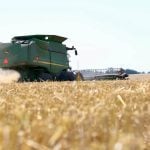This summer, I asked a farming neighbour of mine in Roblin, Man., how his operation has been affected by the pandemic.
Other than having to put on a mask a few times when he went to pick up supplies, he couldn’t think of a single way he had to change how his farm does business.
Rural farms that do not rely on close-quarters working or living conditions are in many ways an ideal business model when it comes to surviving the pandemic.
Agriculture is an essential service and even though its supply chains and markets faced pandemic-related challenges, they are still in business.
Read Also
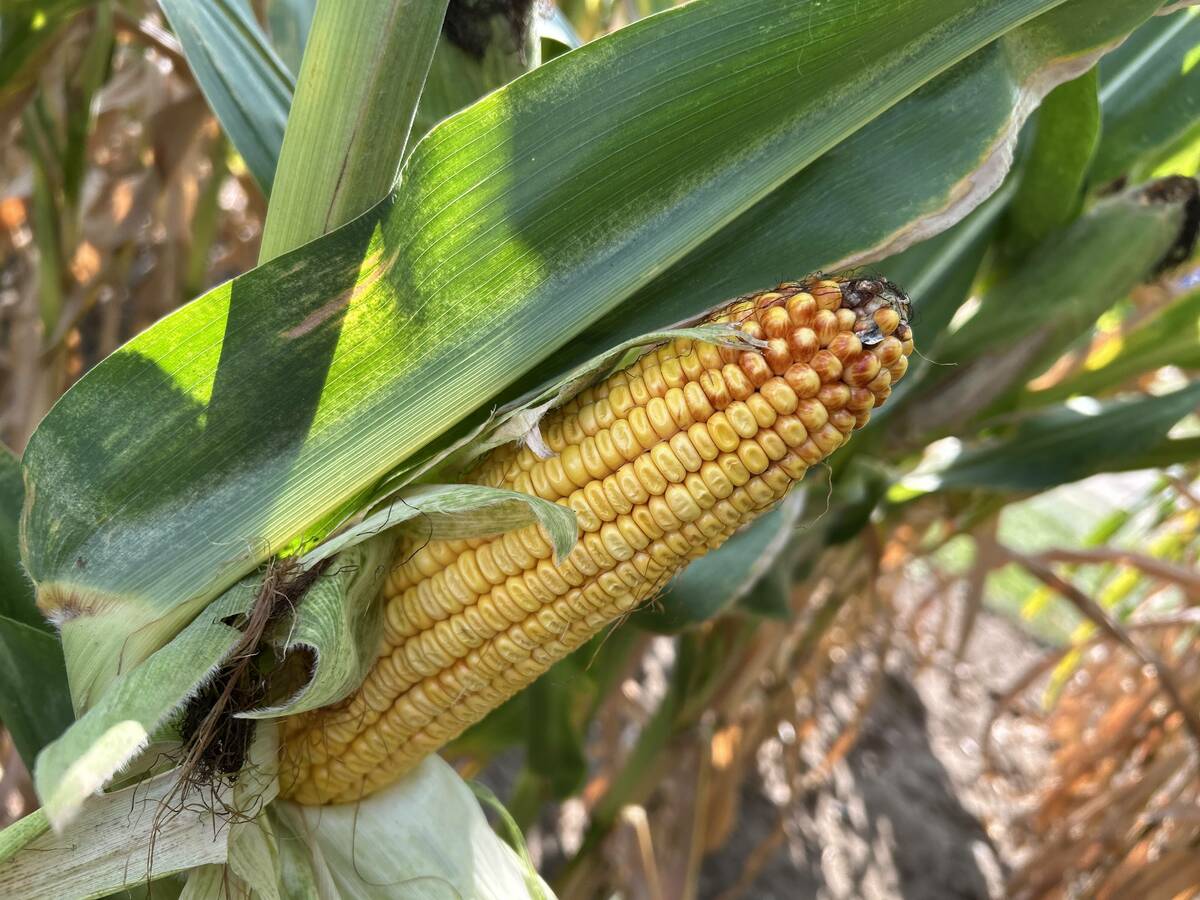
Crop estimates show mixed results
Model-based estimates used by Statistics Canada showed the 2025/26 crop year has seen increases in canola, corn for grain, oats and lentils production while seeing dips in spring wheat, durum wheat, soybeans and barley in comparison to 2024/25.
It’s also easy to socially distance when your closest neighbour is kilometres away, not metres.
But even farms that haven’t been directly affected by COVID-19 are starting to feel the pressure from the second wave that began this fall.
For instance, frontline health workers are being increasingly diverted to deal with COVID-19 outbreaks, including at long-term care homes in the Prairies.
So it may be business as usual for farms in the area, providing their staff do not need medical attention.
Farms most affected by the first wave of the pandemic were largely fruit and vegetable operations and in communal living settings where many employees work or live in relatively close proximity with each other.
However, when schools were shuttered last March almost everyone with children, including farmers, scrambled to figure out what to do with their kids, or without employees who had to stay home to help care for, and minimize risks to their children.
This was the case on Devon Walker’s 3,000-acre grain farm near Lashburn, Sask., which struggled to cope with a labour shortage when key employees had to stay home.
“My go-to-guy who is a jack-of-all-trades, can drive anything, now he could only be there for part of the time because his wife’s work schedule was all jumbled. So was his work schedule, so that they could isolate and stay safe to protect their child,” Walker said.
He said his farming operations were negatively affected because machinery sat when they should have been working in key times in both spring and the fall.
As well, the Canada Emergency Response Benefit that gave $2,000 per month to employed and self-employed Canadians directly affected by COVID-19 made it harder for Walker to find help.
“A lot of the people I talked to only wanted to work for cash under the table for fear of disrupting their CERB emergency payments,” Walker said.
To adjust to reduced labour availability, Walker added more machinery so that when labour was available they could get more done.
“We were going to have lots of part-time workers in and out so we opted to get a second combine, because when we did have helpers most of them were after four o’clock in the day so we could be more productive when we did have that help,” Walker said.
The farm also bought a grain bagger for added flexibility during harvest, for when there were not enough operators to run the combines and the trucks at the same time.
He said his input retailers and the elevators where he delivers grain were also challenged by the pandemic because they had staff that needed to isolate, but they did an excellent job of serving him this summer.
“They were stressed, but as a business owner you can’t fire someone because their kid can’t go to school, and you can’t get rid of somebody because they have to isolate. That’s not right or fair,” Walker said.
“You still need employees but you also don’t want to jeopardize their health and safety. Just accept that your business isn’t going to run as efficiently even though you need it to. It’s just not going to be what it used to be.”
David Wiens runs a dairy barn with his brother near Grunthal, Man., and he said the increased biosecurity protocols brought in because of COVID-19 were a natural extension to the formal biosecurity program they already follow.
He said when a milk transporter comes to the farm, they try to make sure there is no one else in the milk house. As well, they have sanitizers available and encourage the use of masks.
“We basically just went down to just having the necessary visits on the farm. Like the transporters, veterinarians, feed delivered. Those are the things that we allow. Other than that we really curtail the traffic onto the farm,” Wiens said.
Every two years the farm has to undergo a biosecurity risk assessment with their herd veterinarians, to demonstrate the procedures they have on the farm related to biosecurity.
“The whole thing about biosecurity is to prevent any kind of disease or health issue from coming on the farm. And if we have something on the farm, the idea is to try to control it. And if you have something on the farm, prevent it from leaving or getting off the farm,” Wiens said.
“The next step towards another level of security between people, the mindset is already there. We were able to adapt that on the farm quite well, the extra level of biosecurity to deal with COVID-19.”
He said there have been a few cases where COVID-19 has made it onto a Canadian dairy farm, where employees had to isolate and outside help had to be brought in to keep the barns running.
However, he isn’t aware of any dairy barns that had to shut down due to the pandemic.
“We have some protocols in place that were put out, in our case by Dairy Farmers of Manitoba, and that was about if the farmer himself gets sick from it they have to quarantine and that means not showing up in the barn,” Wiens said.
“We don’t want the people who are sick with COVID to be there. We don’t want it to spread to other staff or family members, and we don’t want them around the animals as well.”
He said the biggest disruption the pandemic has had on the dairy industry so far has been some of the market volatility.
There was a spike in milk demand when the pandemic first hit last March. Then with the food service industry shuttered, demand for some of the industrial products like cheese or butter fell dramatically.
“It took a while for processors, retailers and others in the chain to make those adjustments. So for a while, we had to slow down our production quite a bit in spring. But since this summer it’s come back and the demand has been much more steady,” Wiens said.
He said milk demand is increasing, but it’s difficult for dairies to quickly ramp up production.
There has also been an increase in the cost of some feed such as dried distiller’s grains because it’s a by-product of ethanol production, which has decreased because of weak demand for fuels across North America.
Lisa Bishop-Spencer of Canadian Chicken Farmers said existing biosecurity protocols in the poultry industry helped reduce disruption over the past nine months, and that none of the poultry barns operating in Canada had to shut down due to the pandemic.
As with dairy, shifts in how poultry was being consumed in the county caused the biggest hurdle the industry faced.
“Food service represents 40 percent of our produce, and food service has been significantly affected by COVID. We did see an uptick in retail purchases because people had to buy the food and cook it at home by themselves,” Bishop-Spencer said.
She said because the poultry industry is a supply-managed sector, it could quickly adjust production to meet changing demand.
“We were able to quickly adjust over allocations for the upcoming period, think of May, June, July, August, and lower production across the country in order to give the system space to breath and not overproduce chickens,” Bishop-Spencer said.

“We didn’t want to be in a situation where if a poultry plant shut down we wouldn’t be able to find another place to process those birds.”
She said there were a couple poultry processing plants that had to temporarily shut down, but the processors were able to redirect the birds to different plants.
“Supply management gave the flexibility, and the adaptability our farmers have is a really good system that was able to adjust things in order to meet the needs of the processor partners and our consumers,” Bishop-Spencer said.
During the pandemic there has been an increase in the number of people cooking chicken at home, and the cuts available at the grocery store changed because it takes far fewer people at the processing plants to put out a whole bird compared to filleted products.
So the Canadian Chicken Farmers started an initiative called Cooped Up, that provides food safety instructions and recipes for consumers learning to cook at home during the pandemic.
Gary Stordy is the director of government and corporate affairs at the Canadian Pork Council. He said the pandemic has exacerbated labour issues in hog barns and strained existing staff.
They put in “longer hours and more hours on the farm because there has been a shortage of labour. In addition to that, maybe some maintenance has been pushed off. That’s been the common theme we’ve heard,” Stordy said.
Pork producers rely on temporary foreign workers (TFW), and while this program is still active, there has been added costs including the necessity of quarantining the employees for two weeks when they first arrive.
Stordy said some of the problems seen in the fruit and vegetable farms that use common housing for TFW employees isn’t an issue for pork producers, because their workers stay for longer periods and typically stay in their own apartment or house.
But there have been instances where employees, TFW and domestic, had to quarantine for a time throughout the pandemic, which left barns short staffed.
Similar to the other confined livestock operations, pig barns already have formal and stringent biosecurity protocols that were quickly updated to account for COVID-19.
“In doing herd management, they (staff) are usually on their own. The only areas that became an obstacle is the lunch room for the most part, and maybe the shower-in and shower-out areas where they get into a new change of clothing,” Stordy said.
He said traffic into the barns is already tightly controlled and protocols for staggering lunch breaks and wearing masks was not a big deal.
The biggest issue some producers complained about was the accessibility of hand sanitizer when the pandemic first hit last year.
Another issue pork producers faced was a hog supply back-up in the wake of some of the slowdowns and even shutdowns of packing plants.
“Producers were having to hold onto their animals longer than they normally would, so that puts stress on how much space is available in the barn, and then the added costs of holding onto the animals,” Stordy said.
There were some instances of euthanasia of weanlings due to processing disruptions earlier this year and a scarcity of finishing space in Canada.
Stordy said there was a huge downturn in the hog market earlier in the year, but that it has recently started to come back.
Janice Tranberg of the Alberta Cattle Feeders’ Association (ACFA) said when the pandemic first surfaced last year feedlots scrambled to understand how to keep their employees safe, but also how to keep their animals well-cared-for when key staff couldn’t come to work.
“I don’t think that’s changed. In fact, it might be even more heightened today because there are more cases. Initially, everybody was focused on the urban centres because that’s where the spread was happening. But as numbers are rising, it’s starting to hit the farms more,” Tranberg said.
ACFA put together a best management practices document to help feedlots deal with the pandemic and they update it as more information becomes available.
Tranberg said they talked to some of the larger farms to see if they had tips for some of the smaller farms that may not have as stringent biosecurity measures in place.
“They had things that when a truck comes into the yard they had to go to a weigh scale so they would say, OK, you can’t get out of your truck. Let’s just do the information through a window, for example,” Tranberg said.
“Or maybe just one person needs to do the feed truck, not two or three people coming in and out of the truck. Let’s make one person dedicated to this position to reduce spread.”
She said ACFA recommends producers stagger lunch times, have people work by themselves when possible, or stay in set work crews.
“Make pods. If you have a job that requires two or three people keep them together, so if there is a spreading, it is contained between those two or three people,” Tranberg said.
“Common sense activities; wear masks, clean your hands. A lot were not allowing people to come into their farm other than delivery trucks, and they could come in, but they had to stay in their vehicle. Common sense approaches.”
Similar to the pork industry, feedlots use the TFW program but these employees also stay for a longer period of time.
“You’re bringing in someone and you likely have an apartment or a house for them. It’s individual living or maybe two people will live together, but it’s not a bunkhouse,” Tranberg said.
“Making sure temporary foreign workers could still come in was important, and making sure that the farmers understood quarantine and what they had to do if their foreign workers were living in homes they provided. There was a lot of learning around that,” Tranberg said.




